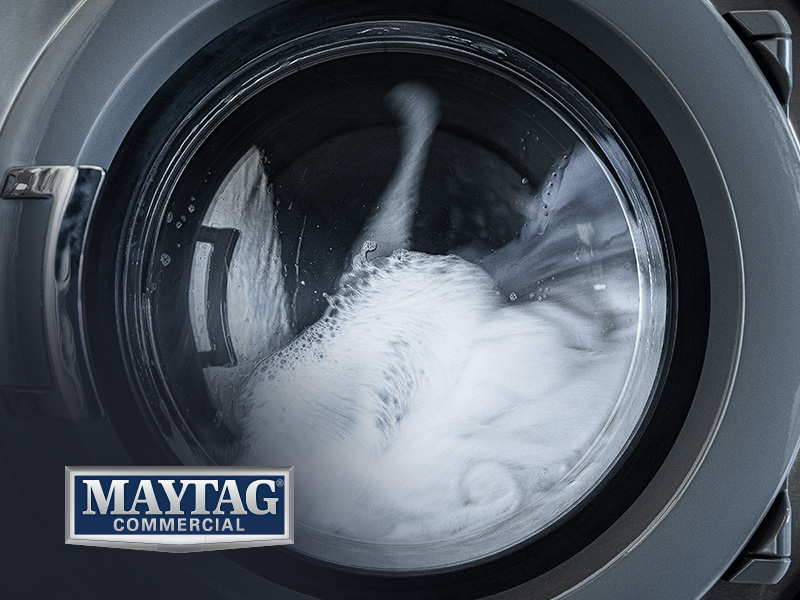Trading Out Old Machines for New High-Efficiency Models Can Generate Across-the-Board Utility Cost Savings
[This is the second in a five-part series of articles expanding on the “equipment equation” for laundromats. In this second installment, we examine one of the key benefits of replacing older equipment with more efficient, technologically advanced models – reduced utility consumption. Lower utility bills are just one more advantage of a laundromat retool, and just one key factor in the equipment equation. We will reveal additional elements of this equation throughout the year.]

Fortunately for operators, vended laundry equipment continues to become progressively more efficient with each new generation of models. At the same time, this means that every 10-year-old washer or dryer that is halfway through its expected service life today likely consumes significantly more utilities than the latest models.
The fact that new, highly programmable machines use less electricity, natural gas and water than older models is one of the strongest incentives for replacing older equipment. Most operators appear to be keenly aware of this advantage – laundromat owners surveyed for a CLA Insights Report on equipment replacement agreed that lower utility costs are one of the main benefits of retooling a laundry.
Replacing Outdated Technology
Steadily rising utility costs – as well as growing water shortages in some parts of the country – have only spurred greater demand for laundry equipment that is more water- and energy-efficient. And technological progress has been impressive.
Gains in water efficiency are particularly significant. In years past, for example, an old 30-pound frontload washer may have used as much as two to three gallons of water per pound of clothing washed, whereas today’s models may use a gallon or less per pound of wash. Toploading machines also have seen a steady reduction in the volume of water used per cycle.
Dryers have become more efficient as well over the years, gaining the ability to remove moisture from clothing using substantially fewer BTUs per pound of water evaporated during the drying cycle.
Additional utility efficiency improvements can be captured by swapping out smaller washers for larger-capacity frontloaders, which use far less water per pound. These upgrades to high-extraction washers reduce drying time – benefitting store owners through lower energy consumption, and their customers through faster service.
Going Green
The laundromat industry may be the perfect example of one in which green, sustainable practices align perfectly with sound business strategy.
An owner’s primary motivation for buying high-efficiency machines may be to cut a laundromat’s expenditures on natural gas, electricity, water and wastewater. However, by retooling with that equipment – which consumes less natural gas and carbon-generated electricity, and produces less gray water – the laundromat also gains the ability to position itself as an eco-friendly business.
In addition to helping cultivate a positive public image, promoting a store as a green enterprise can help differentiate the laundromat from its competition and enhance the business’ bottom line – especially in eco-conscious communities and in regions of the country experiencing water shortages and usage restrictions. In such areas, communicating the efficiency of laundromat equipment will position the laundromat as a community asset, where customers can wash with less energy and water waste.
Cutting the Expense Ratio
According to the most recent CLA Industry Survey, the average laundromat spends 22 percent of gross revenues to cover the costs of water, sewer, gas and electricity. As a general rule, stores with older washers and dryers see that ratio push to 30 percent or higher, depending on the age of their machines and vend pricing. But, by trading out old equipment for new models, a laundromat that’s fully updated with today’s high-efficiency washers and dryers can achieve an expense ratio as low as 15 percent to 20 percent. According to that same CLA survey, the most profitable laundromats (those reporting more than 20 percent net profit) experience an average expense ratio for utilities at just 19 percent.
Upgrading a laundromat’s equipment is a clear winner when it comes to reducing utility costs. Given that, owners should closely track their usage to make well-informed replacement and upgrade decisions, as well as work with their commercial laundry equipment distributor to calculate expected costs and savings generated by specific replacement scenarios. With those numbers in hand, a laundry business will have taken the first important step toward cutting usage and boosting the store’s bottom line.











